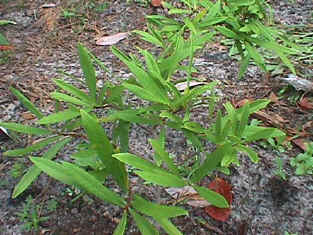
Host plant to the Zebra Swallowtial. Small to medium-sized deciduous shrub or small tree, seldom taller than 25 feet. Leaves turn yellow in autumn.

Culture
Soil and Fertility: Sandy to deep, organic, well-drained, grows best in slightly acid soil (pH 5.5 7.0). Water needs vary with species.
Light: Plant in full sun to partial shade. Although capable of fruiting in the shade, it performs best on sites with full-sun exposure, but with protection from wind. Seedlings will not survive under full sun conditions because the young shoot is extremely sensitive to sunlight. Shading for the first year and sometimes the second is usually required. Grown in full sun the pawpaw develops a pyramidal shape, with dense, drooping foliage down to ground level. In the shade it has a more open branching habit, with few lower limbs and horizontally held leaves.
Mature size: 12" to 35', depending on species
Propogation: Seed, with germination
usually occurring the following season. Seed is slow to germinate, but germination
is not difficult if certain precautions are followed. Do not allow seed to dry out,
because this eventualy destroys the immature dormant embryo. To break dormancy, the
seed must receive a period of cold temperature (stratification) lasting 90-120 days. This
may be accomplished by sowing the seed outdoors in the garden in the fall and letting the
seed overwinter there, the seed will germinate the following year in late July or August.
Or the seed may be stratified in the fridge at 32-40F. Store in plastic bags
containing slightly moistened sphagnum moss to keep moist and suppress fungal/bacterial
growth. After 90-120 days, the seed should be removed from the fridge and sown in a
well-aerated soil mix of pH 5.5-7.0 at temps of 75-85F. On average the root will
emerge from the seed coat after 18-24 days, develop into a taproot about 10 inches long,
and then send up a shoot after 50-60 days. You must have at least 2 trees to
pollinate flowers and get seeds.
Pawpaws have very long taproots, which make them difficult to transplant. It would
seem natural to propagate a clone by transplanting rootsuckers, but since pawpaws commonly
sucker fro the roots, but in practice this is extremely difficult and usually ends in
failure. Rootsuckers normally have no secondary roots for a great distance from the
shoot. Without secondary roots, the shock of transplant is too great, and the
root-sucker dies. Seedling trees have been successfully transplanted. They
should be transplanted in the spring, at the time that new growth commences of soon after.
If many roots are damaged, it may be desirable to prune the top to bring it into
balance with the remaining roots. Although difficult to transplant, once
established, it is vigouous and easy to maintain. The key to successful
transplanting from the wild lies in 5 rules: Transplant seedlings for best results;
Keep the roots and soil intact as much as possible; Transplant in spring after budbreak,
not in fall or winter; Plant in well-drained site, and keep trees well watered the first
year; Provide partial shading for the first year or two.
Pawpaws are easily propogated by a number of grafting and budding techniques. Shoot
cuttings have proven virtually impossible to root. Grafting scions of known
cultivars or selections from the wild that exhibit desirable traits onto seedling
rootstocks is one of the best method of establishing new trees.
Hardiness: Zone
There are a variety of different species, and the flowers can be white, greenish-white, pink or maroon. Narrow-leaf pawpaw (A. angustifolia) has leaves that are more long and narrow. It's flowers are ivory to pale yellow. It grows in north and north-central Fla and prefers well-drained, sandy soil.
Pawpaw is a tree of temperate humid zones, requiring warm to hot summers, mild to cold winters, found natively from the Gulf Coastal plain to southern Michigan. Usually found in Pine flatwoods and sandhills.
Extra care should be given to trees for the first two years to promote growth as the root system establishes itself. Keep the plants well watered and partially shaded for the first year or two. Fruit production normally begins when the trees reaches 6', usually after five to seven years.
The friuts of all Fla pawpaws are edible. They are small, usually only two to three inches long, and have a banana-like flavor, and are also relished by wildlife.